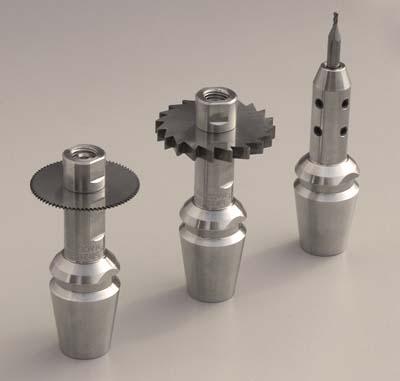
GenSwiss offers the new Ti-Loc SwissClamp Slitting and Milling Tool Holders for increased rigidity, higher quality, longer tool life, and enables quick change of tooling into fixed locations. Designed to direct mount to any ER 16 collet holder using standard ER nuts, the taper integrated Ti-Lock tool holders extends micro endmills closer to the workpiece and eliminates inaccuracies caused by "tolerance stacking." Typical TIR is held to .0002" or better. All mating surfaces are precision ground.
According to Jim Gosselin, GenSwiss founder and president, "The Ti-Loc taper integrated design eliminates a collet and allows the operator to pre-set tool length out of the machine. For both sawing and milling, repeatable positioning is a given as well as increased rigidity, For example, the endmill extension holder permits extended reach in tight spaces without have to hang a small diameter endmill out far, causing chatter or tool life issues due to lack of rigidity. Overall the design concept simplifies the tooling through less components."
Arbors are available for 5mm, 8mm, and ¼" and 5/16" ID saws with more sizes in development. Micro Endmills Extensions will be available to hold 3mm, 4mm, 1⁄8" and 3/16" shanks with more sizes developing. Installation or changing the Ti-Loc Tool Holder is fast and easy. Installation simply requires a twist and snap into any ER clamping nut. No special holding nut is required. The quick change is accomplished by loosening the clamping nut allowing the tool holder to break from the locking taper of the spindle or sleeve.
Contact Details
Related Glossary Terms
- chatter
chatter
Condition of vibration involving the machine, workpiece and cutting tool. Once this condition arises, it is often self-sustaining until the problem is corrected. Chatter can be identified when lines or grooves appear at regular intervals in the workpiece. These lines or grooves are caused by the teeth of the cutter as they vibrate in and out of the workpiece and their spacing depends on the frequency of vibration.
- collet
collet
Flexible-sided device that secures a tool or workpiece. Similar in function to a chuck, but can accommodate only a narrow size range. Typically provides greater gripping force and precision than a chuck. See chuck.
- endmill
endmill
Milling cutter held by its shank that cuts on its periphery and, if so configured, on its free end. Takes a variety of shapes (single- and double-end, roughing, ballnose and cup-end) and sizes (stub, medium, long and extra-long). Also comes with differing numbers of flutes.
- gang cutting ( milling)
gang cutting ( milling)
Machining with several cutters mounted on a single arbor, generally for simultaneous cutting.
- gang cutting ( milling)2
gang cutting ( milling)
Machining with several cutters mounted on a single arbor, generally for simultaneous cutting.
- inner diameter ( ID)
inner diameter ( ID)
Dimension that defines the inside diameter of a cavity or hole. See OD, outer diameter.
- milling
milling
Machining operation in which metal or other material is removed by applying power to a rotating cutter. In vertical milling, the cutting tool is mounted vertically on the spindle. In horizontal milling, the cutting tool is mounted horizontally, either directly on the spindle or on an arbor. Horizontal milling is further broken down into conventional milling, where the cutter rotates opposite the direction of feed, or “up” into the workpiece; and climb milling, where the cutter rotates in the direction of feed, or “down” into the workpiece. Milling operations include plane or surface milling, endmilling, facemilling, angle milling, form milling and profiling.
- sawing
sawing
Machining operation in which a powered machine, usually equipped with a blade having milled or ground teeth, is used to part material (cutoff) or give it a new shape (contour bandsawing, band machining). Four basic types of sawing operations are: hacksawing (power or manual operation in which the blade moves back and forth through the work, cutting on one of the strokes); cold or circular sawing (a rotating, circular, toothed blade parts the material much as a workshop table saw or radial-arm saw cuts wood); bandsawing (a flexible, toothed blade rides on wheels under tension and is guided through the work); and abrasive sawing (abrasive points attached to a fiber or metal backing part stock, could be considered a grinding operation).
- tolerance
tolerance
Minimum and maximum amount a workpiece dimension is allowed to vary from a set standard and still be acceptable.
- total indicator runout ( TIR)
total indicator runout ( TIR)
Combined variations of all dimensions of a workpiece, measured with an indicator, determined by rotating the part 360°.
